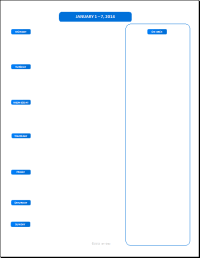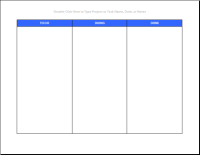The Awesome Power of the Humble Clipboard
If you want to skip all this background and just zip
down the page to the method, click HERE, or
skip to the specific products used further down. |
|
How do you react when someone walks up to you holding a clipboard?
You probably have at least a mild sense that they're either going to start asking you questions, or inspect the fit of your uniform. Why? Because clipboards have a SECRET POWER. Aside from being a tool of mild intimidation and suspicion, they also are absolutely awesome when they have the right pieces of paper clipped to them.
We're going to walk through the simple process of how a clipboard may change your life in a moment, but first we're going to touch on the reasons that standard organizer tools often don't cut it on their own.
Software
If you sit at a computer all day and sync your mobile device to your computer, this section is a little irrelevant. But even if you DO sit at a computer a lot, you may want to ponder this.
You may or may not have used tools like ACT, Microsoft Outlook, iCalendar, or one of the dozens of other task management applications to organize your time and activities. You may have even used clever spreadsheets or Google Docs to tackle the same challenge. But you know the problem with software for ongoing task management? You have to LAUNCH IT AND USE IT. This is really quite fine if most of your work takes place at a computer, but is the best way to hide your own agenda from yourself if you don't. And even if you DO sit at a computer a lot, the short-term information you need may be quite buried in the interface.
Binders/Planners
For a long time, I experimented (occasionally with some success) with using physical planners or binders to organize my tasks and projects. And while this can work with ongoing complex projects that need daily attention, it more often ends up being a clever way to "memorialize" your actions out of existence. You set up that great folder or binder with all the content brilliantly sorted out, and then you PUT IT ON A SHELF. Or worse yet, a stack somewhere in your workspace. "PHEW! I sure am glad THAT task is taken care of! Oh. Wait. It's a week behind!!!!" Perhaps even more useless is a branded planner that looks really cool, but forces you to adapt to ITS style of organizing. Looks cool, but probably eats up more of your brain power than just trying to keep all the info in your head.
The Clipboard to the Rescue
Okay, this sounds dumb, but you really have to see it in action or try it to realize its awesome power. The great thing about a clipboard is that it maintains spontaneity while allowing you to stay focused. Plus, it's very portable, and adaptable. I'll include an example of exactly how I personally use one below, but here's basically what you need:
1.) A Clipboard
2.) Paper
3.) A pen or pencil
4.) A Poly Envelope (optional) |
Got that? Or should we walk through that again? Okay, good.
What is most important here is WHAT KIND OF PAPER you
put
in that clipboard. Especially as the top sheet.
And what is second most important is HOW YOU MANAGE those sheets of paper.
MY METHOD
Here's my personal setup, and the rationale for why:
I - The Top Sheet - Weekly & On Deck
 |
You can make this really simple, or "church it up" like I have. Through repeated use over time, I became a little blind to the simple text version and decided to "pretty it up". If you want to download these and take a look, right-click and "save as". Here's my "prettified" version  , and here's one in simple text  . You can modify them as you see fit. |
Here's how I use it:
One day a week (usually Sunday evening) I round up all my
random
notes about tasks and projects and do two things:
1.) Comb them for things that need to occur on a specific day of the coming week
2.) Sort them by project or focus area, and prioritize them on a basic level |
I then place the things that need to be scheduled on the appropriate day, and things that can't or don't need to be scheduled in the "On Deck" box on the right. This puts the basic appointments I might forget in a handy, highly visible place, while keeping ongoing tasks right in view as well. When I have unexpected openings throughout the week, I can tap that generalized list to see if there are things I have time to do. This takes the GTD "Do, Defer, Delegate" system and puts it into constant action
II - Second Sheet(s) - Day's tasks and meetings
Obviously, that weekly sheet doesn't offer room for granular detail, so for certain days,
I map things out in a bit more detail. The items on this page include:
Scheduled items like meetings and appointments in time order
Unscheduled items like random errands, calls, and emails in a sidebar |
There's then plenty of room on this sheet for miscellaneous notes, so at the end of the day I extract any new useful information, sort items that are more like static file content (new contacts, detailed or lengthy project notes, etc) and file them where they belong, and place bulleted references to "live" items on the weekly sheet in the "On Deck" section.
III - Third Sheet - Monthly calendar
I jot things that are beyond the current week here, but the real reason to keep this handy is because no matter how I've tried, I've never been able to use an electronic calendar with as much speed and efficiency as a paper one!
IV - Fourth Sheet (sometimes) - TO DO/DOING/DONE
 |
During hectic periods when multiple projects and tasks are overwhelming me, I keep a classic "DO/DOING/DONE" sheet with three boxes on it handy. I freestyle a bit here depending on the nature of the projects and their complexity. Here's an example  |
V - Some blank white paper, Some blank graph paper
Or you may prefer lined paper. I have to do a lot of note-taking and sketching or drawing of things that are in grids, so I prefer clean white pages or graph paper for things that need to be more precisely specified in terms of dimensions.
VI - A Poly Envelope
You may not find this necessary, but for me the whole problem with any kind of notebook or folder that closes completely is that it obscures the content of my action list and makes it that much easier to ignore. And since I seem to have some ADD-like condition that has yet to be officially diagnosed, that is a BIG NEGATIVE. I use a simple poly envelope with a snap, as pictured below. This makes the clipboard more totable and gives me a place to slip loose sheets of paper, but keeps my day right in front of me if I need to check it quickly. |




